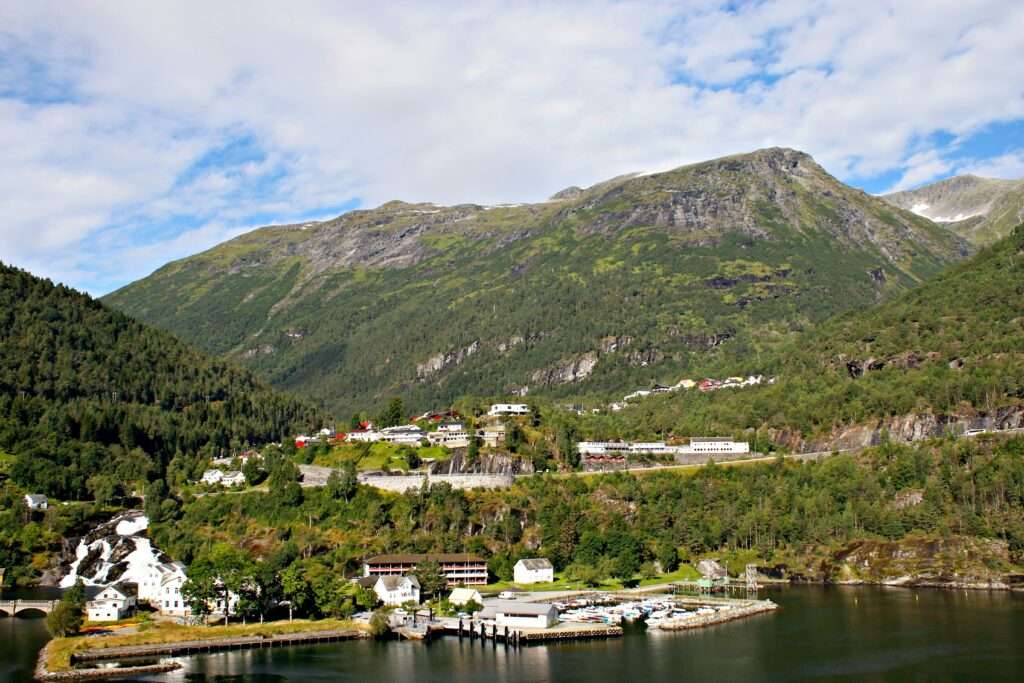Last Updated on 13 May 2025 by Johan
Geiranger and it´s fjord are examples of Mother Earth at her most beautiful and impressive. Today the Geirangerfjord is the second most important cruise destination in Norway, with well over a hundred ships calling in the summer as well as the Coastal Steamer (Hurtigruten).
In 2005, the Geiranger Fjord , as part of the West Norwegian fjord landscape, was added to UNESCO’s World Heritage List. The fjord landscape, with its peculiar climatic and geological conditions, is considered one of the most beautiful and most fjord areas on the planet. In addition, you will find remnants of older farms and barns of great cultural value. Large parts of the Geirangerfjord and its surroundings are landscape conservation areas, and Norway has also committed itself to protecting and safeguarding the world heritage area for future generations.
The Geirangerfjord is perhaps the world´s most famous fjord; whether or not it is the most beautiful is something you must decide for yourself.
The village has welcomed tourists since 1869 when the first tourist ship sailed into the fjord. The hospitable inhabitants began already then to transport the royal doctor and other tourists to the viewpoint by horse and cart, and later, with beautiful, open cars. A hundred years ago, there were actually more cars per inhabitant in Geiranger than in New York, and some of the cars are still in the village.
Norwegian Fjord Center
A visit to the Norwegian Fjord Center gives you an insight into the area both as it was then, and as life is now. Remember that the Ørnevegen to Geiranger from Eidsdal is open all year round, and that all seasons have their charm from the crazy green spring to the wintry white fjord landscape.
Flydalsjuvet
One of the world´s most famous photographic subjects is the Flydalsjuvet gorge, with its springboard-shaped rock formation, seemingly poised between earth and sky, is the best known view point. You yourself can be a part of it. Just off main road No. 63. Parking
Dalsnibba
Viewpoint 1,500 metres above seal level (Toll road). Incredible views of the Geiranger Fjord and surrounding scenery. Dependent on weather conditions. The Nibbevegen Route takes you from Djupvasshytta at 1,038 meters above sea level to the Dalsnibba approximately 45 minutes from Geiranger.
The route was constructed on the initiative of Geiranger Skysslag which also paid a considerable part of the cost of GBP 12,800. The route was opened in 1939, having taken 3 years to build.
Knuten
Drivable section of the original Geiranger Road that as opened in 1889. An example of first class civil engineering. (Near RV 63). There were 9 stonebridges on this road, and one of them is “Knuten”. The name comes from the fact that you first have to drive under the bridge and then, after a 270 degree curve, you are on top of the Bridge.
Eagle Road / Ørnevegen
11 hairpin bends are an important ingredient on this easy tour. View of Preikestolen and De Syv Søstre waterfalls. Excellent spot for watching cruise ships entering the fjord.
Skageflå Farm
The most famous of the mountain farms. Moderately fit people can reach it on a good mountain path from Homlong. Attained fame when Queen Sonja and King Harald invited over 30 Royal guests to lunch in the farm courtyard when they celebrated their silver wedding in 1993.
Waterfalls and fjords by boat
You have probably heard of the seven sisters, the Friar and the Bridal Veil. These waterfalls are best experienced from the fjord, whether you take the ferry by car between Geiranger and Hellesylt, or by RIB or kayak. Geiranger Fjordservice also offers tours by sightseeing boat.

Storseterfossen
Waterfall where you can walk behind the falls. Walk for about 50 minutes on a good path from Vesterås farm. Suitable for all ages, but good foot wear is necessary.
The Seven Sisters (De syv søstre)
Standing on the deck of the boat and feeling the spray of the water from these waterfalls is a unique experience. The tallest of these has a free fall of 250 meters.
Friaren Waterfall
According to the legend, Friaren Waterfall wooed De Syv Søstre Waterfalls on the other side of the fjord. The fjord sightseeing cruise passes close to Friaren.
How to get to Geiranger
The road from Eidsdal is open all year round, and you can get here by car, bus or boat. Note that there are slightly different offers in summer and winter, and it is wise to plan in advance. Plane – The nearest airport is Ålesund Lufthamn Vigra (approx. 2.5 hours). Bus – public transport at www.frammr.no . Boat – From Ålesund with Geiranger Fjordservice , also winter cruises . Hurtigruten and Havila Kystruten in season. Ferry – Since 2022: year-round ferry between Geiranger and Hellesylt, www.frammr.no.
Car – Geiranger can boast several of the most spectacular viewpoints in western Norway. You pass Ørnesvingen on the way to or from Geiranger if you come by car. The winding roads are an experience in themselves, but remember to stop at the viewpoint and enjoy the view. From the center you can drive further up the other road towards Stryn. Here you first pass Flydalsjuvet, and then you come all the way up where you can turn off to Dalsnibba . This part of the road is closed in winter. The road to Geiranger is part of the National Tourist Route Geiranger-Trollstigen.